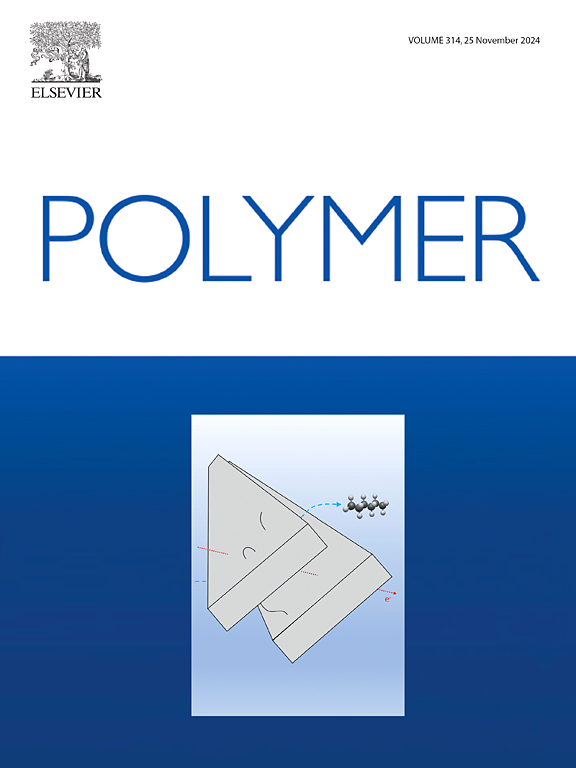调节聚衣康酸甘油的迈克尔加合物:反应后的功能化途径
IF 4.5
2区 化学
Q2 POLYMER SCIENCE
引用次数: 0
摘要
聚衣康酸甘油骨架上的C=C双键通过聚合后反应促进其功能化。其中,aza-和thio-Michael加成反应具有改善材料性能的潜力,但它们在聚衣康酸甘油中的应用仍未得到充分探索。为了弥补这一空白,我们用无毒且可生物降解的衣康酸和甘油合成了聚衣康酸甘油(酯化度为71.0%),然后用l -半胱氨酸(改性度为24.8-96.9%)进行Michael添加改性,这是一种无毒的二胺替代品,以前用于类似的反应。通过红外光谱(FTIR)、核磁共振(NMR)和热分析证实了聚衣康酸甘油的成功功能化,证实了Michael加合物的存在。通过湿接触角测量(<90°)证明了交联材料的亲水性,而对24小时提取物的细胞毒性测试表明,在两个测试样品中没有细胞毒性作用(>70%)。这些发现强调了聚衣康酸甘油衍生物作为有前途的材料在组织工程和相关领域的进一步应用潜力。本文章由计算机程序翻译,如有差异,请以英文原文为准。


Tuning the poly(glycerol itaconate)'s Michael adducts: Post-reaction pathways to functionalization
C![]() C double bonds in the poly (glycerol itaconate) backbone facilitate its functionalization through post-polymerization reactions. Among these, aza- and thio-Michael addition reactions hold the potential for improving material properties, yet their application to poly (glycerol itaconate) remains underexplored. To address this gap, we synthesized poly (glycerol itaconate) (esterification degree = 71.0 %) using non-toxic and biodegradable itaconic acid and glycerol, followed by its modification via Michael addition with l-cysteine (modification degree = 24.8–96.9 %), a non-toxic alternative to diamines previously used in similar reactions. The successful functionalization of poly (glycerol itaconate) was confirmed through FTIR, NMR, and thermal analyses, verifying the presence of Michael adducts. The hydrophilicity of the crosslinked materials was demonstrated by wet contact angle measurements (<90°), while cytotoxicity tests on 24-h extracts indicated no cytotoxic effects in the two tested samples (>70 %). These findings underscore the potential of poly (glycerol itaconate) derivatives as promising materials for further applications, such as tissue engineering and related fields.
C double bonds in the poly (glycerol itaconate) backbone facilitate its functionalization through post-polymerization reactions. Among these, aza- and thio-Michael addition reactions hold the potential for improving material properties, yet their application to poly (glycerol itaconate) remains underexplored. To address this gap, we synthesized poly (glycerol itaconate) (esterification degree = 71.0 %) using non-toxic and biodegradable itaconic acid and glycerol, followed by its modification via Michael addition with l-cysteine (modification degree = 24.8–96.9 %), a non-toxic alternative to diamines previously used in similar reactions. The successful functionalization of poly (glycerol itaconate) was confirmed through FTIR, NMR, and thermal analyses, verifying the presence of Michael adducts. The hydrophilicity of the crosslinked materials was demonstrated by wet contact angle measurements (<90°), while cytotoxicity tests on 24-h extracts indicated no cytotoxic effects in the two tested samples (>70 %). These findings underscore the potential of poly (glycerol itaconate) derivatives as promising materials for further applications, such as tissue engineering and related fields.
求助全文
通过发布文献求助,成功后即可免费获取论文全文。
去求助
来源期刊

Polymer
化学-高分子科学
CiteScore
7.90
自引率
8.70%
发文量
959
审稿时长
32 days
期刊介绍:
Polymer is an interdisciplinary journal dedicated to publishing innovative and significant advances in Polymer Physics, Chemistry and Technology. We welcome submissions on polymer hybrids, nanocomposites, characterisation and self-assembly. Polymer also publishes work on the technological application of polymers in energy and optoelectronics.
The main scope is covered but not limited to the following core areas:
Polymer Materials
Nanocomposites and hybrid nanomaterials
Polymer blends, films, fibres, networks and porous materials
Physical Characterization
Characterisation, modelling and simulation* of molecular and materials properties in bulk, solution, and thin films
Polymer Engineering
Advanced multiscale processing methods
Polymer Synthesis, Modification and Self-assembly
Including designer polymer architectures, mechanisms and kinetics, and supramolecular polymerization
Technological Applications
Polymers for energy generation and storage
Polymer membranes for separation technology
Polymers for opto- and microelectronics.
 求助内容:
求助内容: 应助结果提醒方式:
应助结果提醒方式:


